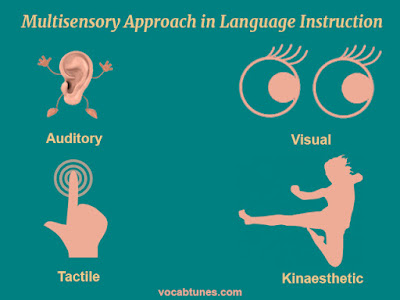Importance of Multisensory Approach in Language Instruction
Children learn in multiple ways. Some learn by seeing things.
Others grasp information when they hear. For some, learning becomes easier when
movements are involved. Therefore, adopting a multisensory approach is
important to teach kids especially in their early childhood.
Multisensory approach makes young children use more than one
sense among the five — sound, sight, touch, smell, taste — in the same activity.
When they use multiple senses to process new information, they are more likely
to grasp it fast and remember it. In a multisensory approach, little ones gain
information in following ways:
- Auditory (through their ears)
- Visual (through their eyes)
- Tactile (through touch )
- Kinaesthetic (through body movements)
For instance, explaining about apples would be easier when
kids have a chance to visually examine, touch, smell, and eat apples rather
than just reading or listening to their teacher about it. The more their senses
are involved, the more their understanding will be.
Let us look at some key advantages of multisensory approach:
- Keeps students engaged in learning
- Increases focus and concentration
- Offers multiple ways to make connections and learn concepts
- Improves memory and ability to retain new information
- Improves communication
- Generates greater capacity for learning
Although, multisensory instructions can be used to teach all
the subjects, it plays an important role in imparting knowledge of languages. Several
programs and activities have been designed, which deliberately use sight,
sound, touch, and movement to help children associate language to words.
When it comes to English language, multisensory techniques help
kids to learn new words, decode their meanings, remember them, and use them
correctly. This, in turn, improves their English scores, gives them confidence
to speak, write, and express their ideas, and enables them to understand
others’ opinions.
Here are some multisensory activities that can be used to make
children familiar with words and enhance their vocabulary:
Sand Writing: Students take a handful of sand, spread it on
a table, and write a letter or word in it using their finger. As they write,
they utter the sound each letter makes and then mix those sounds together to
read the whole word aloud.
Word Building: It can be done with color-coded tiles or
magnetic letters in which vowels are one color and consonants another. Children
utter each letter’s sound as they lay it down and read out the word loud once
they have built it.
Shared Reading: Kids join in or share the reading of a book
or other text with a teacher. They may follow along as the teacher reads aloud
or while they listen to an audio version of the book.
In addition to these options, Vocab Tunes — an interactive learning
program — is a great way to help children gain an extensive vocabulary. Its K-2 grade W/CD product helps kids of this age group understand the concept of root
words with the aid of interactive workbook and educative song tracks. This way,
little ones can master the English language while singing and dancing their own
way.


Comments
Post a Comment